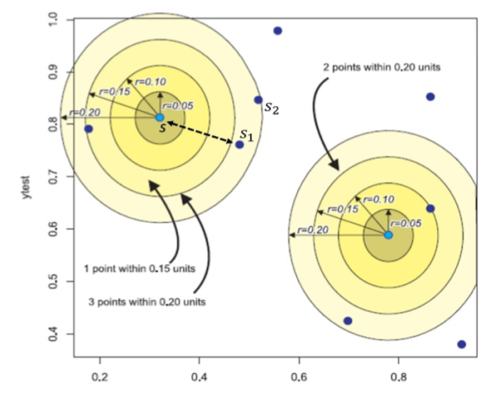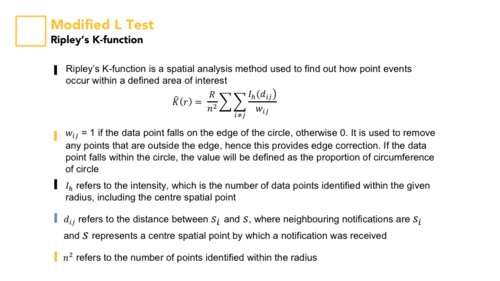Difference between revisions of "ANLY482 AY2017-18 T2 Group 31 Model Buidling and Analysis"
Jump to navigation
Jump to search
| Line 54: | Line 54: | ||
<p></p> | <p></p> | ||
<b>Modified L Test via Ripley's K Function</b><br> | <b>Modified L Test via Ripley's K Function</b><br> | ||
| − | To determine: | + | To determine: <br> |
1. If the notifications appear to be clustered or randomly distributed in our area of interest<br> | 1. If the notifications appear to be clustered or randomly distributed in our area of interest<br> | ||
2. Minimum radius distance which shows signs of statistically significant clustering | 2. Minimum radius distance which shows signs of statistically significant clustering | ||
| Line 62: | Line 62: | ||
[[File:RKFunctionFormula.png|500px|]] | [[File:RKFunctionFormula.png|500px|]] | ||
</div> | </div> | ||
| + | Number of observed notifications is compared to the number of notifications expected based on Complete Spatial Randomness (CSR)<br> | ||
| + | CSR assumes distribution of points is homogeneous over the study area<br> | ||
| + | Null hypothesis: the spatial points are randomly distributed, using alpha = 0.01<br> | ||
Revision as of 20:02, 14 April 2018
Model Building
Model Building
Modified L Test via Ripley's K Function
To determine:
1. If the notifications appear to be clustered or randomly distributed in our area of interest
2. Minimum radius distance which shows signs of statistically significant clustering
Number of observed notifications is compared to the number of notifications expected based on Complete Spatial Randomness (CSR)
CSR assumes distribution of points is homogeneous over the study area
Null hypothesis: the spatial points are randomly distributed, using alpha = 0.01


